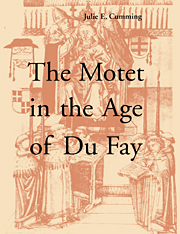Book contents
- Frontmatter
- Contents
- List of tables
- List of musical examples
- Acknowledgments
- Notes to the reader
- Introduction
- Part I Models and methods
- Part II Motets in the early fifteenth century: the case of Bologna Q15
- Part III Motets in the mid-fifteenth century: the case of the Trent Codices
- Conclusion
- Appendix: Widely disseminated motets
- Notes
- Bibliography of books and articles
- Modern editions of music
- Sources and sigla
- Notes on the index of works
- Abbreviations for subgenre identifications
- Index of works
- General index
Conclusion
Published online by Cambridge University Press: 22 September 2009
- Frontmatter
- Contents
- List of tables
- List of musical examples
- Acknowledgments
- Notes to the reader
- Introduction
- Part I Models and methods
- Part II Motets in the early fifteenth century: the case of Bologna Q15
- Part III Motets in the mid-fifteenth century: the case of the Trent Codices
- Conclusion
- Appendix: Widely disseminated motets
- Notes
- Bibliography of books and articles
- Modern editions of music
- Sources and sigla
- Notes on the index of works
- Abbreviations for subgenre identifications
- Index of works
- General index
Summary
In the preceding pages I have mapped out the radical transformation of the motet over the course of Du Fay's lifetime. This map looks something like Darwin's great evolutionary tree: some subgenres die, while others branch off from old ones. The motet's evolutionary tree, however, has even more interconnections and intertwinings than Darwin's, since many of the subgenres have multiple antecedents. I have summarized my findings in Tables C.1–3 (pp. 298–303). The different subgenres, their antecedents and descendants, are listed in Table C.1; other genres that influenced the motet are listed in Table C.2; and a diagram of the subgenres and their interconnections is given in Table C.3. We are now in a position to look back and narrate the history of the motet during the first three-quarters of the fifteenth century, and to bring into relief the “selection pressures” – features of the political, social, cultural and musical environment – that help explain why the motet evolved the way it did.
Subgenres in Bologna Q15
The Council of Constance (1414–18) and the French victory over the English at Agincourt (1415) meant that musicians and composers from many different regions were exposed to each other and to each other's music. During and after these events composers began to travel as never before: English musicians came to the Continent, while composers and singers trained in the North increasingly traveled south to Italy in search of more rewarding employment.
- Type
- Chapter
- Information
- The Motet in the Age of Du Fay , pp. 288 - 303Publisher: Cambridge University PressPrint publication year: 1999



